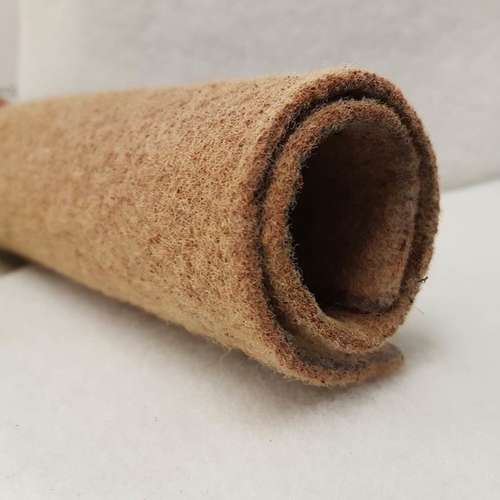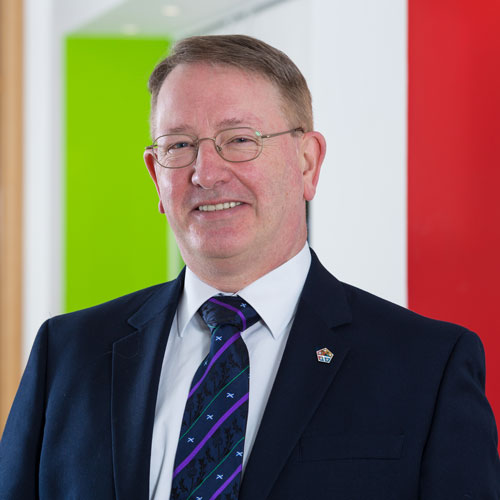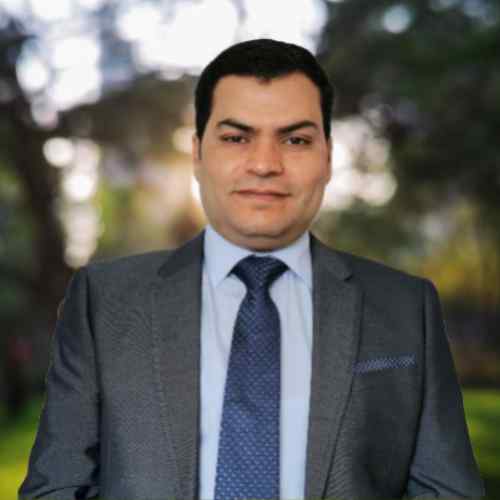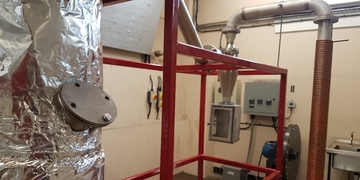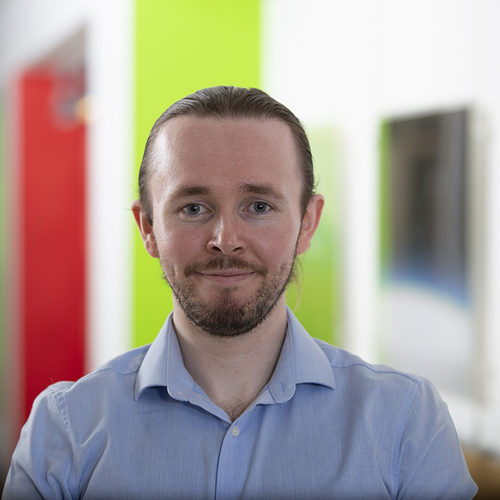
Dr David Bryce, Research Associate, Laboratory Manager
Research Biography
David’s PhD research focused on fundamental research of the composite interphase region, a key parameter in composite material performance. This work investigated the effects of fibre sizing and processing parameters and was funded by wind turbine manufacturer Suzlon. Other areas of research interest include sizing performance at high temperatures and polymer curing behaviour.
Current Project
David is currently working full time as part of a composite upcycling consortium comprised of the University of Strathclyde, Aker Offshore Wind, Cubis Systems, GRP Solutions and Composites UK. The project aims to push lab-scale composite recycling technology to the next stage of commercial implementation.
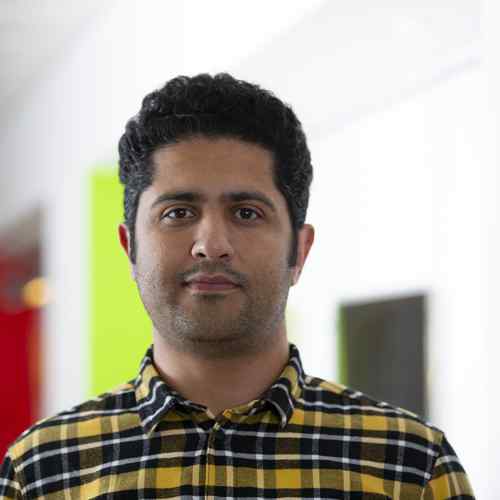
Dr Ramin Moradi, Research Associate
Research Biography
Ramin’s PhD investigated power generation from low-grade heat sources using micro-scale organic Rankine cycle (ORC) systems for waste heat recovery (WHR) and trigenerative (CCHP) applications. His research interests include waste recovery systems, such as heat, agro-industrial residues, municipal solid residues, and fibre-reinforced composite materials (FRCs). He also investigates the design and modelling of energy of systems and thermal processes.
Current Project
Ramin is currently working full-time as part of a composite upcycling consortium comprised of the University of Strathclyde, Aker Offshore Wind, Cubis Systems, GRP Solutions and Composites UK. The project aims to push lab-scale composite recycling technology to the next stage of commercial implementation.
![Profile picture of Guillermo Idarraga Alarcon [2021] Profile picture of Guillermo Idarraga Alarcon [2021]](/media/departments/mechanicalengineering/compositematerials/photos/500x500/Guillermo-I.jpg)
Dr Guillermo Idarraga Alarcon, Research Associate
Research biography
Guillermo Idarraga holds a PhD in the subject of high-performance composite materials with pseudo-ductile behaviour and MEng in the subject of railway lubrication systems and multibody simulations. He has participated in different projects gaining experience in numerical modelling, standard tests, and manufacturing methods of composites materials.
Current projects
Guillermo is currently working as a full time research associate on the project Bionic Adaptive Stretchable Materials for WEC (BASM-WEC) which is funded by the EPSRC. The aim of this project is to develop an analysis and laboratory testing integrity toolbox to reliably design, analyse and process state of the art adaptive stretchable materials and structures applicable to Wave Energy Convertors.

Dr Wichain Chailad, Research Assistant
Research Biography
Wichain’s PhD research focused on investigating the slurry erosion behaviour of rubbers and rubber composites used as sacrificial liners in the equipment used in slurry transport applications. This work was funded by Weir Minerals. Other areas of research interest include a novel synthesis route to manufacturing in situ-synthesised silica as a filler in rubber materials for high-slurry erosion-resistant rubber liners.
Current Project
Wichain is currently working as a part-time research assistant on an industry-sponsored project. The project aims to develop and investigate particulate-filled thermoplastic composites for flooring applications.

Ashlee Espinoza, Research Assistant
Current Project
Utilisation of fibre reinforced composites in highly corrosive mediums
Project description
Currently, pump and valve components that are exposed to highly corrosive mediums are made from metallic materials. One of the primary causes of failure in metallic designs is corrosion and erosion. Many measures are taken in order to mitigate damage caused by the working environment. An alternative to the preservation of metal components is the replacement of such parts with composite materials. Polymer matrix materials with fibre reinforcement exhibit high mechanical properties and are already extensively used in a variety of large-scale applications. They are non-conductive by nature and therefore offer a solution to the current challenges when using metals in these applications.
Due to the complexity of component designs polymer matrix composites are not currently utilised. This requires fundamental research into micro and macro scale computational analysis of components. Additionally, due to the modes of failure in composite materials there is not currently an agreed upon method for fatigue analysis and life prediction. Aims of the project include developing methods for modelling and analysing possible defects for better prediction. This research is undertaken in conjunction with the Weir Group.
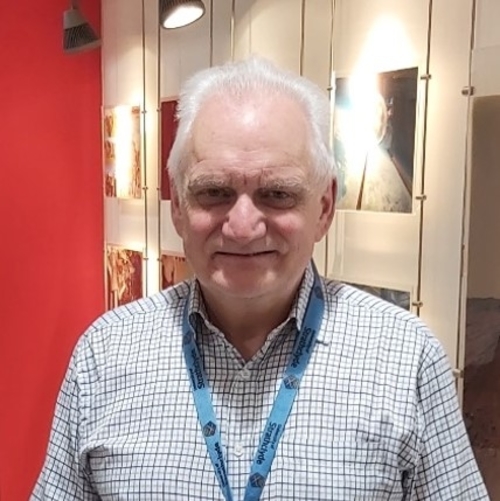
Chris Cameron, Laboratory manager / PhD student
Expertise
- Design, Manufacture and Analysis of laminar Fibre Reinforced Polymer structures.
- Material Selection and Manufacturing Protocols for Component Design.
Current Project
The optimal design of a light weight composite pressure vessel by use of cellular core sandwich structures
Project description
This research looks at the design and analysis of cellular core sandwich structures. These structures, in the form of plates and shells can give a much higher strength to weight ratio than their solid alternatives. The main aim of the work is to derive a theoretic protocol to analyse the efficiency of cellular core sandwich structures. A literature review of all relevant engineering theories will reveal the best stress calculation methodology to model the dominant stresses in flat plates and curved shells with cellular core sandwich structures. A finite element model will be constructed to allow visualisation of stress fields and corroboration of the results of the calculated stresses.
An experimental program will be designed and implemented. The first set of tests will be designed to find the basic material properties of the structures. The second testing program will be designed to test the plate and shell structures under pressure and will require a dedicated test rig.
The conclusion will bring theoretical, finite element and experimental results together, in order to determine the effectiveness of cellular core structures in light weight pressure vessel design.
Chris' background
After completing an engineering apprenticeship, Chris spent ten years in industry as a service engineer in the material testing and analysis. He graduated from the Open University with a BA in mathematics, before joining the University of Strathclyde in 1993 as a laboratory supervisor. Chris has since graduated from Strathclyde University with an MSc in Materials Engineering and has become the departmental laboratory manager. He has now embarked on a course of study towards a research PhD.

Miguel Ubago Torres, PhD student
Current Project
Additive layers for avoiding/delaying delamination in composite materials.
Project description
Composite materials with a polymeric matrix and a fibre reinforcement structure are susceptible to develop and suffer from delamination, which is a crack between their layers. Delamination caused by different loading scenarios such as simple as in-plane loads, transverse impact , stress concentration points or fatigue.
The focus of the project is to study the delamination growth stress-intensive free edges and discontinuities and come up with solutions for avoiding delamination.
Miguel’s background:
Miguel comes from Madrid, Spain. He is an industrial engineer specialised in mechanics, formed in Polytechnic University of Madrid. He did his degree final project at Oslo and Akershus University College, HiOA, in Oslo, Norway, and his master thesis at the Laser Centre of Polytechnic University of Madrid.
He has an attitude of continuous learning and expects to develop a successful project in composite materials at University of Strathclyde.

Sheik Abdul Malik, PhD student
Current Project
Composite manufacturing techniques with reduced cycle time and cost for automotive applications
Project description
Current part fabrication process is only good enough for low volume cars but for use in mass produced vehicles, there is a need for dramatic process improvisation. With the advent of electric cars & other mobility solutions to replace the traditional automobiles, the drive to achieve environmental & economic targets for all industry sectors is intense. The benefits of lightweight composite structures contribute to these targets. Hence it is imperative to have a feasible standardization process in place for composites manufacturing to be widely adopted in the industry.
Malik’s background:
Prior to beginning my PhD I gained experience at ACCIS, Bristol in Design for Manufacture of composites. I was responsible for developing Virtual Fabric Placement (VFP) simulation program designed for producing composite parts ‘right the first time’. Implementing the Industry 4.0 methodologies and integrating VFP with various available ICT platforms, the solution was validated and demonstrated to be useful in an industrial scale, thereby improving process efficiency and enabling a closed loop design and manufacturing cycle.
During time at Airbus I was involved in the A350 XWB winglets design and production team. Additionally, I was in charge of Long Range stress and 330 NEO programme.
I am in pursuit of a game changing idea and am hopeful that this PhD journey will help me get closer to this goal. I’m your go to man to chase a daring new innovation. Come find me if you are on the verge of a breakthrough.

Shima Dayarian, PhD student
Current Project
Synthesis and Parametric study of Novel Aerogel Composites
Project description
Development of novel aerogel materials is an important technological area in the UK. These materials offer attractive material performance in energy saving, oil recovery, and water purification. A typical aerogel material is characterised by its highly porous texture, which is further described by pore size distribution and interpore connectivity. By carefully tailoring these structural features during aerogel synthesis, the physiochemical properties of the final aerogel can be manipulated for a specific application. Despite these superior material properties and design flexibility, monolithic aerogels tend to be mechanically weak and rigid. This has a negative impact on its machinability and consequently limits aerogel’s applications in a wider market.
The aim of this project is to 1) Develop a novel synthesis route to manufacturing the polyamide aerogels; 2) Characterise and compare physiochemical properties of the monolithic gel and the composite gel; 3) comparing the properties of the new method sample with other methods.
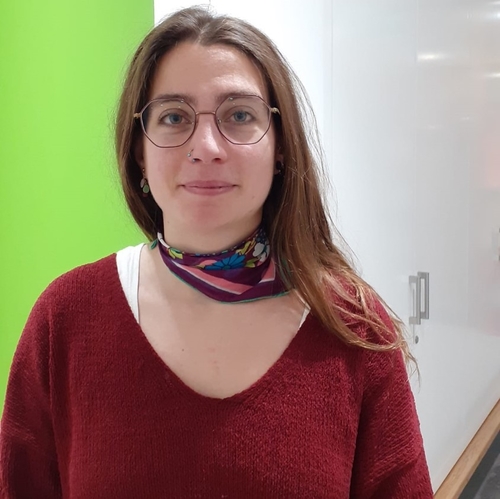
Beatriz Casares Fernández, PhD student
Current Project
Understanding the relation between the micro and macro scale interfacial strength in natural fibre composite materials
Project description
The widespread use of synthetic fibre composite materials has brought many benefits to engineering and energy development, but also many challenges. One of the latter is the environmental impact that these materials have when coming to the end of their life cycle. Developing new composite materials using natural fibres in combination with biodegradable matrices is one of the steps forward in order to achieve further development without compromising the future of our planet.
Understanding the interaction between the natural fibres with the matrix at the interface plays a key role to enhance the mechanical properties of natural-fibre composites. On one hand, tests like short beam strength or V-notched shear use specimens in order to obtain the shear properties at a macro scale level. On the other hand, the microbond test is used to measure the interfacial shear strength in an individual fibre-microdroplet system. Understanding how the results from both worlds connect and explain the interface behaviour using finite element analysis modelling will lead to finding a cost-effective coupling agent in the endeavour of pushing natural fibres to their limits.
This is a project funded by the Royal Academy of Engineering in collaboration with the National University of Colombia and Compañía de Empaques S.A. The study of the interface of fique fibre along with different thermoplastic matrices, focusing on biodegradable ones, plays a key role in the development of a new composite material reinforced with natural fibres. This new material, which aims to support structural loads, is being explored for small wind turbine blades for electrification of rural areas using local materials in South America. “
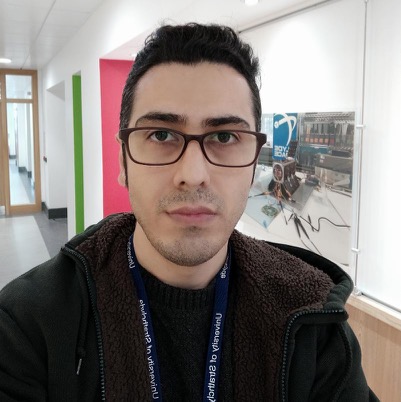
Hossein Rohani, PhD student
Current Project
Out-of-Autoclave Processing Development of Aerospace Carbon Fibre-Polymer Composites
Project description
Composite materials are faced with high market demands because of their superior properties, particularly in the aerospace industry. However, high time-and-energy consuming manufacturing processes, and consequently higher final product costs, are serious barriers to more widespread use in this area. Currently the autoclave process is a common and trusted manufacturing method because of void free and excellent quality of products. However, this method requires a relatively large amount of energy to prepare the pressurized and heated environment during the curing stage of carbon fibre reinforced polymers (CFRPs).
In this project, both experimental and numerical approaches will be applied to decrease the curing time and energy usage of a production cycle by studying epoxy curing kinetics and heat dissipation through the part. The need of using one-sided or double-sided heated moulding and various heating patterns, as well as effect of epoxy aging on thermoset properties, are included in the project plan. The insights gained will reduce CFRP product costs by improving energy efficiency of manufacture without sacrificing composite quality.

Damilola Aje, PhD student
Current Project
Developing Polymer Composite Structure for Processing Corrosive Fluids
Project description
Despite the fact that polymer composites have been extensively used in various chemical-related applications (e.g. tanks and pipes), long-term resistance against hot concentrated chemicals still remains extremely challenging for most polymer composites today. Composite design for this type of applications can be further complicated when the composite structure is going to be used to process chemical fluids such as rotatory propellers in engineering pumps. As a result, fluid-structure interaction needs to be investigated for composite design under coupled thermo-chemical environment.
This project is aimed to develop a novel design process and manufacturing route to producing corrosion-resistant composite structure for controlling chemical fluids such as sulphuric and phosphoric acids.
The key challenges that will be addressed in this project involve:
- Material selection and characterisation for chemical resistance at elevated temperatures.
- Composite structure design for fluids control using FEA.
- Component prototyping using 3D printing for complex geometry.
Damilola's background
Damilola has been in the oil and gas industry as a Senior Design Engineer prior to joining the PhD programme. He has first-hand experience in the design and assessment of piping systems, having started his engineering career as a Piping Systems Engineer in 2002. He has eighteen years’ industrial experience and knowledge in piping design, pipework assessments and Pipe stress analysis and has worked across many engineering design companies both in Africa and in the United Kingdom.
He is a corporate member of the Institution of Mechanical Engineers (IMechE) and is also a Chartered Engineer with IMechE.
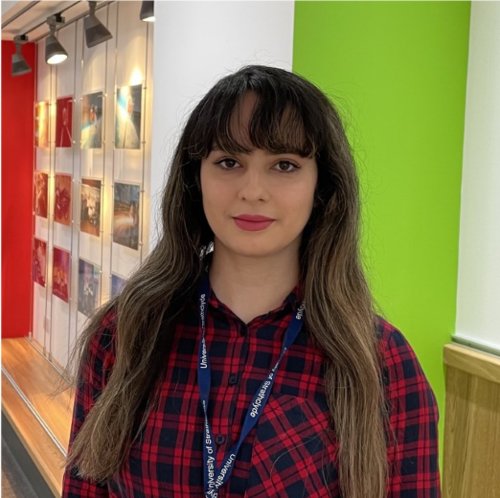
Roya Akrami, PhD student
Current Project
Investigating fibre-matrix interface and developing improved sizing for glass fibre-matrix bonding
Project description
Glass fibre products account for more than 95% of fibre reinforcements used in high performance and light-weight composite materials. Possibly the most critical component involved in the manufacture of glass fibres and their composites is the fibre sizing. The formulation and implementation of sizing is the key for a cost-effective production, processibility and optimized performance of glass fibre composites.
The project aims to work on the development of novel sizings for glass fibre reinforced composites with improved performance and sustainability. Sizing formulation is being investigated and characterised for fibre manufacturability, fibre performance, and fibre-matrix interfacial properties. This new material may have applications in different sectors including aerospace panel, wind turbine blades, and automotive parts.

Andrew Carlin, PhD student
Current Project
Re-shaping fibre-reinforced composites: non-circular glass fibres for enhanced composite properties
Project description
The ongoing desire to lightweight structures for cost and environmental factors has required continuous innovation in glass fibre production and their composites. Innovation has typically come in the form of sizing and composition developments. However, developments in these areas are considered to be high up on their development S-curves and thus innovation is required elsewhere. Changing of the fibre cross-section offers both an opportunity to improve composite performance and add an additional layer of design.
The aim of this project is to characterise non-circular fibres already available on the market and develop design considerations for new products. Through multi-level characterisation an understanding of the origins of improvements will be investigated. Simultaneously, questions will be asked of the status quo and of models established in the past 100 years of fibreglass development. This requires a holistic approach with testing at the fibre, interface and laminate level combined with modelling work. Collaboration with Nippon Electric Glass and RWTH Aachen adds additional technical expertise and capability to the project.
With improvements spanning a broad range of properties, new non-circular glass fibre products could be utilised across multiple sectors with different design requirements and to provide robust solutions in areas previously not considered.
Andrew's background
Andrew is a recent graduate from the Mechanical & Aerospace department at Strathclyde. His prior industrial experience spans from building composite wind turbines in rural Peru to internships as a Fire Engineer in the consultancy sector. Andrew spent a year in industry at the National Composites Centre, developing insight into the complexities of composite R&D across a broad range of production processes and sectors, in collaboration with different companies from SMEs to multinationals. Driven by continuous improvement, he wants to see the development of more efficient materials and processes to cut back waste and our impact on the environment.
ACG alumni
Dr Mariusz Kucharek
Project: Investigation of Key Challenges Facing Aerogel Composites Development Through Multiscale Approach. No at Leyton UK in Glasgow.
Dr Andrew Webley
Project: Development of fibre and particulate filled aerogel composites for subsea pipeline applications.
Dr Sairah Bashir
Project: Development of a cost-effective chemical approach to regenerate surface properties of thermally recycled glass fibre for reuse in composites. Now at Lightweight Manufacturing Centre, part of the National Manufacturing Institute Scotland in Glasgow.
Dr Ross Minty
Project: The Influence of Matrix Stoichiometry on Interfacial Adhesion in Composites for Wind Turbine Applications. Previously at Far Composites in Nottingham, now returned to the ACG as Lecturer in Composites Sustainability and Reinforcement
Dr Ulf Nagel
Project: Towards Affordable, Closed-Loop Recyclable Future Low Carbon Vehicle Structures – (TARF-LCV). Now at Brandenburger Group.
Dr José-Luis Rudeiros Fernández
Project: Improving the Impact Performance of Injection Mouldable Natural Fibres Polyolefin Compounds for Lightweight Automotive Applications. Now at CERN in Geneva.
Dr Eduardo Sáez-Rodríguez
Project: Regenerated Composite Value Reinforcement (ReCoVeR). Now at Glencore Zinc.
Kerrie Downes
Project: Interface in glass fibre reinforced polyamide composites (with 3B – The Fibreglass Company). Now at Aggreko in Glasgow.
Dr Chih-Chuan Kao
Project: Regenerated Composite Value Reinforcement (ReCoVeR). Now at Industrial Technology Research Institute in Taiwan.
Dr R.T. Durai Prabhakaran
Project: Towards Affordable, Closed-Loop Recyclable Future Low Carbon Vehicle Structures – (TARF-LCV). Now an Associate Professor at Indian Institute of Technology Jammu.
Dr Fiona Cullinane
Project: Characterisation of Environmentally Friendly Fibres for Composites. Now at Scottish Power.
Susan Roch
Project: Development of a meso-scale test for carbon-fibre reinforced composites. Now at Subsea 7.
Discover more about some of our exciting research projects
Advances in polymer aerogel insulation
A recent collaboration with Blueshift Materials has led to exciting advances in polymer aerogel composite blankets